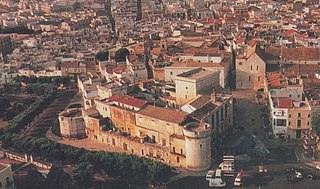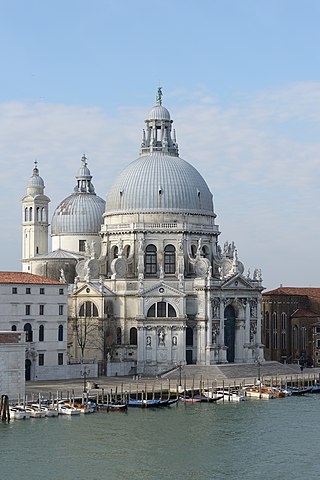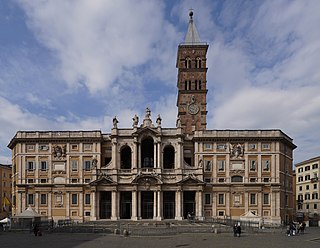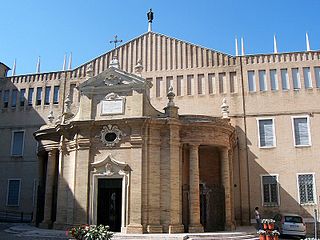
The term Black Madonna or Black Virgin tends to refer to statues or paintings in Western Christendom of the Blessed Virgin Mary and the Infant Jesus, where both figures are depicted with dark skin. Examples of the Black Madonna can be found both in Catholic and Orthodox countries.

Conversano is an ancient town and comune in the Metropolitan City of Bari, Apulia, south-eastern Italy. It is 30 kilometres (19 mi) southeast of Bari and 7 kilometres (4 mi) from the Adriatic coast, at 219 metres (719 ft) above sea level.

Santa Maria della Salute, commonly known simply as the Salute, is a Roman Catholic church and minor basilica located at the Punta della Dogana in the Dorsoduro sestiere of the city of Venice, Italy.

Pinturicchio, or Pintoricchio, also known as Benetto di Biagio or Sordicchio, was an Italian Renaissance painter. He acquired his nickname because of his small stature and he used it to sign some of his artworks that were created during the fifteenth and sixteenth centuries.

The Basilica of Santa Maria in Trastevere ; English: Our Lady in Trastevere) is a titular minor basilica in the Trastevere district of Rome, and one of the oldest churches of Rome. The basic floor plan and wall structure of the church date back to the 340s, and much of the structure to 1140–43. The first sanctuary was built in 221 and 227 by Pope Callixtus I and later completed by Pope Julius I. The church has large areas of important mosaics from the late 13th century by Pietro Cavallini.

Prato Cathedral, or Cathedral of Saint Stephen, is a Roman Catholic cathedral in Prato, Tuscany, Central Italy, from 1954 the seat of the Bishop of Prato, having been previously, from 1653, a cathedral in the Diocese of Pistoia and Prato. It is dedicated to Saint Stephen, the first Christian martyr.

The Basilica of Saint Nicholas of Tolentino is a Roman Catholic church and minor basilica that is part of the Augustinian monastery in the hill-town of Tolentino, province of Macerata, Marche, central Italy. The church is a former cathedral of the Roman Catholic Diocese of Tolentino, suppressed in 1586.

Our Lady of Graces or Saint Mary of Graces is a devotion to the Virgin Mary in the Roman Catholic Church. Several churches with this dedication often owe their foundation to thankfulness for graces received from the Virgin Mary, and are particularly numerous in Italy, India, Australia, United States, Portugal, France and the Italian-speaking region of Switzerland. Also it is related to the Marian apparitions in which was revealed the Miraculous Medal, also known as the Medal of Our Lady of Graces.

Catholic Marian churches are religious buildings dedicated to the veneration of the Blessed Virgin Mary. These churches were built throughout the history of the Catholic Church, and today they can be found on every continent including Antarctica. The history of Marian church architecture tells the unfolding story of the development of Catholic Mariology.

Jacopo Zoboli, also known by Giacomo, was an Italian painter of the Baroque style.

The Santuario della Madonna Consolata is a Catholic minor basilica and Marian shrine in central Turin, Piedmont, Italy. Located on the intersection of Via Consolata and Via Carlo Ignazio Giulio, the shrine is dedicated to the Blessed Virgin Mary under the title of Our Lady of Consolation.

A pilgrimage church is a church to which pilgrimages are regularly made, or a church along a pilgrimage route, like the Way of St. James, that is visited by pilgrims.

The Basilica of Santa Maria Assunta is a 14th-century basilica in Alcamo, province of Trapani, Sicily, southern Italy. It is named after the Assumption.

The Sanctuary of Madonna dei Miracoli is a church in Alcamo, province of Trapani, Sicily, southern Italy; it is dedicated to the Madonna of the Miracles.

Madonna di Sant'Alessio(Madonna of St. Alexis; Madonna of Intercession) is an icon, probably of Byzantine origin, of the Blessed Virgin now in the Basilica of the Saints Bonifacio and Alexis on the Aventine Hill in Rome, Italy.

Sarsina Cathedral is a Roman Catholic cathedral in Sarsina, a municipality in the province of Forlì-Cesena, region of Emilia-Romagna, Italy, dedicated to the Annunciation of the Virgin Mary. Formerly the seat of the Bishops of Sarsina, since 1986 it has been a co-cathedral of the Diocese of Cesena-Sarsina.

The Basilica of Santa Maria della Quercia is a Renaissance-style, Roman Catholic sanctuary church and minor basilica, about two kilometer outside of the center of Viterbo, on the road to Bagnaia, in the Region of Lazio, Italy.

Santa Maria della Misericordia is a Renaissance-style, Roman Catholic basilica church and Marian shrine located on Piazza San Vincenzo Maria Strambi, next to the Cathedral, in the center of Macerata, region of Marche, Italy.

Montalto Cathedral, otherwise the Basilica of Santa Maria Assunta e San Vito, is the principal Roman Catholic church of the town of Montalto delle Marche, province of Ascoli Piceno in the region of Le Marche, Italy. It is dedicated to the Assumption of the Virgin Mary. The church was formerly, from 1586, the episcopal seat of the Diocese of Montalto. When the diocese was subsumed into the present Diocese of San Benedetto del Tronto–Ripatransone–Montalto in 1986, Montalto Cathedral became a co-cathedral in the new diocese. It was created a basilica minor by Pope Paul VI in 1965.

The Cathedral of Our Lady of the Snows is the main place of Roman Catholic worship in Nuoro, Sardinia, and the cathedral church of the diocese of Nuoro.























